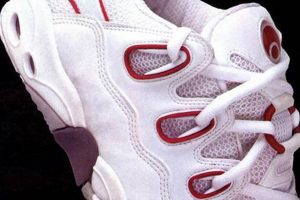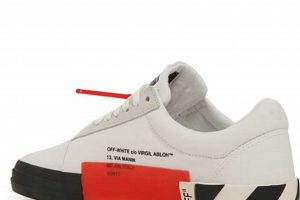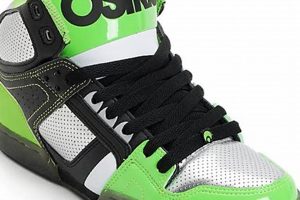Footwear designed to withstand the rigors of skateboarding, typically featuring durable construction, reinforced stitching, and specialized soles for optimal grip and board feel, are paramount for the activity. These shoes often incorporate features like padded collars and tongues for enhanced comfort and protection against impact. A well-constructed example offers both performance enhancement and injury mitigation.
The selection of appropriate footwear for skateboarding provides significant benefits. It fosters improved control and precision during maneuvers. Further, it provides protection against common skateboarding injuries, and contributes significantly to the longevity of the activity by ensuring user comfort and reducing fatigue. Historically, the evolution of this type of specialized shoe mirrors the progression of skateboarding itself, with advancements in materials and design driven by the needs of the sport.
Subsequent sections of this article will delve into specific considerations for selecting appropriate models, examine key features that contribute to performance and durability, and provide guidance on maintaining the footwear to extend its lifespan. The discussion will also cover different styles and their suitability for various skateboarding disciplines.
Essential Considerations for Durable Skate Footwear
The following guidelines aim to provide skaters with vital information to maximize the performance and lifespan of their footwear. These insights are critical for both novice and experienced skaters, ensuring safety and optimizing investment in specialized equipment.
Tip 1: Reinforce High-Wear Areas: Apply shoe glue or a similar adhesive to areas prone to abrasion, such as the toe and ollie patch. This preemptive measure extends the lifespan of the footwear by reinforcing vulnerable points.
Tip 2: Employ Shoe Shields: Internal shields or inserts designed to protect the inside of the shoe, particularly in the toe region, are highly recommended. These reduce wear from toe drags and other internal friction.
Tip 3: Rotate Footwear Regularly: Avoid wearing the same pair of skate shoes every session. Rotating between multiple pairs allows each to decompress and dry thoroughly, mitigating premature wear and tear.
Tip 4: Opt for Vulcanized or Cupsole Construction: Vulcanized soles offer superior board feel and flexibility, while cupsole construction provides increased durability and impact absorption. The selection depends on individual skating style and priorities.
Tip 5: Prioritize Suede or Leather Uppers: Suede and leather are more resistant to abrasion compared to canvas or synthetic materials. Selecting shoes with these uppers enhances overall durability.
Tip 6: Regularly Clean Footwear: Keeping skate shoes clean not only improves their appearance but also prevents the accumulation of dirt and debris that can accelerate wear. Use a soft brush and mild detergent for cleaning.
Tip 7: Tighten Laces Properly: Ensure that laces are adequately tightened to provide support and prevent excessive movement inside the shoe. This reduces friction and prolongs the life of the lacing system.
Implementing these tips contributes to improved shoe longevity, enhanced performance, and decreased expenditure on replacement footwear. Adhering to these guidelines ensures a more sustainable and cost-effective approach to skateboarding.
The subsequent section will explore specific footwear models known for their durability and performance characteristics, providing practical recommendations for skaters of varying skill levels.
1. Durability
The capacity of skate shoes to withstand the abrasive forces inherent in skateboarding is a primary determinant of their overall quality and value. Skateboarding subjects footwear to repeated impact, friction against the skateboard deck, and contact with rough surfaces. Therefore, the durability of the shoe directly correlates with its lifespan and the frequency with which it must be replaced. Inadequate durability translates directly to increased expenditure on footwear and potential compromise of performance due to equipment failure. For example, a shoe constructed with thin canvas and minimal reinforcement will likely succumb to wear within a few sessions, whereas a shoe utilizing reinforced suede and durable stitching can withstand significantly more use.
Specific design elements significantly influence the durability of skate shoes. These include the use of high-abrasion resistant materials such as suede or leather for the upper, reinforced stitching in high-stress areas like the toe and ollie patch, and construction techniques that bond the sole securely to the upper. Cupsole construction, for instance, often provides greater durability and impact absorption compared to vulcanized construction, though the latter offers enhanced board feel. Furthermore, features such as rubber toe caps and reinforced eyelets contribute to the overall resilience of the footwear. Professional skateboarders often rely on shoes with enhanced durability features to endure the demanding nature of their daily routines.
The relationship between durability and overall quality is undeniable. Selection of durable skate shoes represents a practical investment that minimizes replacement costs and ensures consistent performance. Understanding the key features that contribute to durability enables skaters to make informed purchasing decisions, selecting footwear that meets the specific demands of their skateboarding style and frequency of use. Failure to prioritize durability can lead to premature wear, compromised performance, and increased financial burden. Therefore, durability stands as a cornerstone of quality in the context of skate-specific footwear.
2. Grip
Grip, in the context of specialized skateboarding footwear, constitutes a critical performance factor directly influencing board control, stability, and overall safety. The outsole composition and tread pattern are primary determinants of a shoe’s ability to adhere to the skateboard deck, enabling precise execution of maneuvers. Insufficient grip compromises the skater’s ability to maintain balance and execute tricks effectively, potentially leading to falls and injuries.
- Outsole Material Composition
The rubber compound used in the outsole dictates the level of friction generated between the shoe and the skateboard. Vulcanized rubber, a common material in skate shoes, provides a balance of flexibility and grip. Softer rubber compounds generally offer superior grip but may exhibit reduced durability, while harder compounds prioritize longevity at the expense of adhesion. The selection of appropriate rubber composition is thus a compromise tailored to individual skating style and preference.
- Tread Pattern Design
The pattern embossed or molded into the outsole further enhances grip by increasing the surface area in contact with the skateboard and providing channels for water and debris to escape. Herringbone, waffle, and geometric patterns are commonly employed in skate shoe outsoles, each offering varying degrees of grip and wear resistance. Deeper treads generally provide superior traction on rough surfaces, while shallower treads optimize board feel and flexibility.
- Sole Construction Method
The method by which the sole is attached to the upper also influences grip performance. Vulcanized soles are bonded to the upper using heat and pressure, resulting in a flexible and responsive connection. Cupsole construction, on the other hand, involves stitching or gluing a pre-molded sole to the upper, offering increased durability and impact absorption but potentially sacrificing some board feel. The choice between vulcanized and cupsole construction reflects a trade-off between grip sensitivity and overall shoe integrity.
- Surface Condition Dependence
The effectiveness of a skate shoe’s grip is influenced by the condition of both the shoe’s outsole and the skateboard deck’s grip tape. Accumulation of dirt and debris on either surface reduces friction and compromises traction. Regular cleaning of both the shoes and the skateboard is therefore essential for maintaining optimal grip performance. Additionally, worn or damaged grip tape must be replaced to ensure adequate adhesion. The interplay between shoe outsole condition and skateboard grip tape condition underscores the importance of diligent maintenance for achieving consistent grip performance.
The preceding elements collectively define the grip characteristics of quality skateboarding footwear. Skaters must carefully consider these factors when selecting shoes to optimize control, enhance performance, and mitigate the risk of injury. Understanding the relationship between outsole material, tread pattern, sole construction, and surface condition dependence empowers informed decision-making, ensuring the selection of footwear that aligns with individual needs and preferences.
3. Comfort
Comfort in skate shoes extends beyond mere pleasantness; it is a crucial factor directly influencing performance, endurance, and injury prevention. Prolonged skateboarding sessions place significant stress on the feet and ankles. Footwear that lacks adequate cushioning, support, or breathability can lead to discomfort, fatigue, and ultimately, a decrease in skateboarding proficiency. Conversely, well-designed, comfortable skate shoes allow skaters to maintain focus and control for extended periods, optimizing learning and skill development. For instance, a skater experiencing foot pain due to ill-fitting shoes is likely to exhibit diminished reaction time and compromised balance, increasing the risk of falls and injuries. Comfort, therefore, is not a luxury but a prerequisite for sustained and effective skateboarding practice.
Several design elements contribute to the overall comfort of skate shoes. Padded collars and tongues mitigate friction around the ankles, reducing the likelihood of blisters and chafing. Ortholite or similar insoles provide cushioning and arch support, minimizing foot fatigue and promoting proper alignment. Breathable materials, such as perforated panels or mesh linings, enhance ventilation, preventing moisture buildup and maintaining a comfortable internal environment. The ergonomic design of the shoe, including the shape of the toe box and the overall fit, ensures that the foot is properly supported and unrestricted. Real-world examples illustrate the importance of these features: professional skaters often endorse shoes specifically designed with enhanced comfort features, citing improved performance and reduced risk of injury as key benefits.
In summary, the connection between comfort and effective skate shoes is undeniable. Footwear prioritizing comfort enables skaters to endure longer sessions, maintain focus, and minimize the risk of injury. While durability, grip, and board feel are also essential considerations, comfort serves as a foundation upon which these performance attributes are built. Challenges remain in balancing comfort with durability and board feel, as some materials and designs that enhance one aspect may compromise others. However, ongoing advancements in materials science and shoe construction continue to yield innovative solutions that address this trade-off, leading to skate shoes that offer a harmonious blend of comfort, performance, and longevity.
4. Protection
In the realm of skateboarding, specialized footwear serves not only as a performance tool but also as a critical component of personal safety. The capacity of a skate shoe to mitigate potential injuries stemming from impact, abrasion, and torsional stress is a defining characteristic of its overall value and efficacy.
- Impact Absorption through Cushioning
Skateboarding subjects the feet and ankles to repetitive high-impact forces. Effective skate shoes incorporate cushioning technologies, such as polyurethane or gel inserts, to dissipate these forces and reduce stress on joints. For instance, landing a jump or trick generates forces several times the skater’s body weight, and inadequate cushioning can lead to chronic conditions like stress fractures or tendonitis. The presence of effective impact absorption is therefore essential for long-term musculoskeletal health.
- Abrasion Resistance via Durable Materials
The constant contact between skate shoes and the abrasive surface of a skateboard deck necessitates the use of highly durable materials in the upper construction. Suede and leather, often reinforced with additional layers in high-wear areas, provide resistance against abrasion and prevent premature failure of the shoe. The ollie patch, for example, is a critical area prone to significant wear, and its reinforcement is directly correlated with the shoe’s lifespan and protective capabilities. A tear in this area exposes the foot to potential injury and compromises the shoe’s structural integrity.
- Ankle Support and Stability
High-top skate shoes and those with reinforced ankle collars offer enhanced support and stability, reducing the risk of ankle sprains and other related injuries. Skateboarding involves dynamic movements and abrupt changes in direction, placing considerable stress on the ankle joint. By providing additional support, these features limit excessive pronation or supination, minimizing the likelihood of injury. The degree of ankle support required is often dependent on the skater’s experience level and the complexity of the maneuvers performed.
- Toe Protection through Reinforced Toe Caps
The toe region of a skate shoe is particularly vulnerable to impact and abrasion, especially during tricks involving foot drags or slides. Reinforced toe caps, constructed from durable rubber or composite materials, provide an additional layer of protection against these hazards. A properly designed toe cap protects the toes from direct impact and prevents premature wear of the shoe’s upper. This feature is especially crucial for skaters who frequently perform tricks that place significant stress on the toe area.
The facets of protection outlined above collectively contribute to the overall safety and well-being of skaters. Selecting skate shoes that prioritize these protective features is a proactive measure that can significantly reduce the risk of injury and prolong participation in the sport. Understanding the relationship between specific design elements and their protective function empowers skaters to make informed purchasing decisions and prioritize their safety.
5. Board Feel
Board feel, within the context of skateboarding, refers to the sensitivity and tactile connection between the skater’s foot and the skateboard deck. This sensory input is critical for nuanced control, precise execution of tricks, and an overall enhanced riding experience. The design and construction of specialized footwear directly influence the degree of board feel transmitted to the skater. Footwear that obscures this connection impedes the skater’s ability to perceive subtle shifts in balance and deck orientation, leading to reduced control and increased risk of misexecution. For instance, a shoe with an excessively thick or rigid sole effectively dampens tactile feedback, making it difficult for the skater to discern minute variations in the deck’s angle or pressure distribution. This, in turn, affects their ability to perform technical maneuvers that demand a high degree of precision.
Specialized skate shoes prioritize board feel through several design features. Thin, flexible soles made from vulcanized rubber are common, as they allow for greater articulation and sensitivity compared to thicker, more rigid cupsole constructions. The outsole tread pattern also plays a role, with shallower patterns providing a closer connection to the deck surface. Additionally, minimal padding in the sole and upper further enhances tactile feedback, although this can come at the expense of impact protection. Real-world examples demonstrate the significance of board feel: professional skateboarders often favor shoes with a low profile and flexible sole, citing improved control and responsiveness as key benefits. These athletes rely on subtle sensory cues to execute complex tricks with precision, underscoring the importance of board feel in high-performance skateboarding.
In summary, board feel is a crucial component of effective skate shoes, directly influencing control, precision, and the overall riding experience. While achieving optimal board feel often involves trade-offs with durability and impact protection, advancements in materials science and shoe design continue to refine the balance between these competing factors. Prioritizing board feel in the selection of skate shoes empowers skaters to maximize their connection with the board, leading to improved performance and a more engaging skateboarding experience. Challenges remain in catering to diverse skating styles and preferences, as some skaters may prioritize board feel while others place greater emphasis on durability or impact absorption. However, a comprehensive understanding of the relationship between shoe design and board feel enables informed purchasing decisions and ultimately contributes to a more rewarding skateboarding experience.
Frequently Asked Questions
The following questions address common inquiries and misconceptions regarding specialized skateboarding footwear. The information provided is intended to clarify critical factors influencing performance, durability, and safety.
Question 1: What distinguishes specialized skateboarding footwear from conventional athletic shoes?
Skateboarding footwear incorporates specific design features tailored to the unique demands of the sport. These include reinforced construction in high-abrasion areas, specialized sole patterns for optimal grip, and enhanced impact protection. Standard athletic shoes typically lack these features, resulting in reduced durability and compromised performance in a skateboarding context.
Question 2: How does sole construction affect the performance and longevity of the footwear?
Vulcanized soles offer superior board feel and flexibility, enabling enhanced control during maneuvers. Cupsole construction provides increased durability and impact absorption, suitable for skaters prioritizing protection and longevity. The choice depends on individual skating style and preferences, representing a trade-off between sensitivity and resilience.
Question 3: Are expensive skate shoes inherently superior in terms of quality and performance?
Price does not guarantee superior quality or performance. While premium models often incorporate advanced materials and construction techniques, less expensive options can provide adequate durability and functionality. Thorough research and consideration of specific features are essential for making informed purchasing decisions.
Question 4: How frequently should skateboarding footwear be replaced?
The lifespan of skateboarding footwear depends on several factors, including the frequency of use, skateboarding style, and the quality of the footwear itself. Regular inspection for signs of wear and tear is crucial. Replacement is recommended when structural integrity is compromised, or performance is noticeably diminished.
Question 5: Is it advisable to use skateboarding footwear for activities other than skateboarding?
While skateboarding footwear can be worn for other activities, its specialized design may not be optimal for all purposes. The reinforced construction and specialized sole patterns may provide limited comfort or functionality in non-skateboarding contexts. Dedicated footwear for other activities is generally recommended.
Question 6: How does one properly care for skateboarding footwear to maximize its lifespan?
Regular cleaning with a soft brush and mild detergent is recommended to remove dirt and debris. Reinforcing high-wear areas with adhesive and utilizing shoe shields can extend the footwear’s lifespan. Rotating between multiple pairs allows each to decompress and dry thoroughly, mitigating premature wear and tear.
The preceding questions and answers provide a foundation for understanding the key attributes of quality skateboarding footwear. Informed decision-making based on these factors ensures both enhanced performance and prolonged equipment lifespan.
The subsequent section will delve into specific brands and models known for their exceptional durability and performance characteristics, offering practical recommendations for skaters of varying skill levels.
Concluding Remarks on Skate Footwear
This exploration has illuminated the critical attributes defining proficient skate shoes, encompassing durability, grip, comfort, protection, and board feel. Each element contributes significantly to both performance enhancement and injury mitigation. Understanding these factors empowers skaters to make informed decisions, optimizing their equipment investment and ensuring a safer, more effective skateboarding experience.
The selection of suitable skate footwear transcends mere preference, representing a strategic imperative for sustained participation and skill progression. Continued advancements in materials and design promise further refinements in footwear technology, fostering enhanced performance and mitigating the inherent risks of skateboarding. Diligent consideration of the principles outlined herein remains paramount for all practitioners of the sport.







